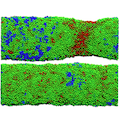Abstract
Although the origin of ductility in crystalline materials is well understood through the motion of dislocations and defects, a similar framework for understanding deformation in amorphous materials remains elusive. In particular, the difference in the mechanical response for small-molecule amorphous solids, such as organic glasses that are typically brittle, and polymer glasses, which are frequently very tough, has not been systematically explored. Here, we employ molecular dynamics simulations to investigate the mechanical response of model glassy polymers confined to a nanoscopic pillar under tensile deformation. We vary the chain length, cooling rate for forming the glass, and the deformation rate and investigate the changes in the mechanical response. We find that samples that are cooled at a slower rate and deformed at a slower rate are more prone to localization of the strain response, or shear banding. Interestingly, this effect is independent of chain length over the range of parameters we have investigated so far, and we believe this is the first direct observation of shear banding in deformed polymer glasses under cylindrical confinement. Finally, by using the isoconfigurational ensemble approach, we provide evidence that the location where the shear band forms is due to structural features that are frozen in place during sample preparation.
